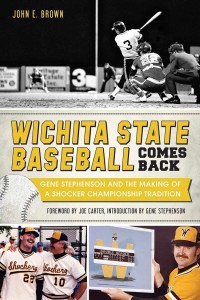 Wichita State Baseball Comes Back: Gene Stephenson and the Making of a Shocker Championship Tradition (The History Press, historypress.net, Charleston, S.C., 2014, 140 pp., 31 black-and-white photos, $19.99 paperback).
Wichita State Baseball Comes Back: Gene Stephenson and the Making of a Shocker Championship Tradition (The History Press, historypress.net, Charleston, S.C., 2014, 140 pp., 31 black-and-white photos, $19.99 paperback).
No one needs to be a fan of Wichita State University baseball, nor—I’m tempted to say—even a fan of college baseball or even baseball itself, to find pleasure in the consistently entertaining narrative that is Wichita State Baseball Comes Back: Gene Stephenson and the Making of a Shocker Championship Tradition (historypress.net). No, this is just good storytelling—fit fare for any reader who likes against-the-odds tales, and especially those told with the kind of irrepressible energy and wryness that is the hallmark of author John E. Brown.
Brown tells the story of a coach’s mission to bring back the sport of baseball to a university that had abandoned the game some seven years prior. And not just bring it back, but make of it a winner, and not just a winner, but a perennial national powerhouse—which is exactly what coach Gene Stephenson did, starting in 1977. And to do it all on a shoestring. By 1982, his Shockers had played themselves into the title game of the College World Series. By 1989, they’d won the title itself. Along the way, they rewrote college baseball record books and they revitalized and in fact changed the sport in ways that can still be seen today.
This is a story, too, of academic hubris, of behind-the-scenes maneuverings, of promises kept and unkept. And this is a story, too, of resourcefulness, of belief in oneself and one’s goals.
I lived in Wichita for 11 years (1984-1995), during a time when more than one motorist would drive 21st Street past the University during gametime only to see a baseball ping off the pavement, having been swatted from the batter’s box some 400-feet-and-more to the south. I watched a time or two from the stands myself as those Stephenson Wheatshocker stalwarts put a whipping on my own beloved—and then highly ranked—OSU Cowboys. They were good, the Shockers.
To give a little added perspective… this from a 2013 article in the Daily Oklahoman that tried to sum up Stephenson’s career at WSU: “Gene Stephenson spent 36 springs in the Wichita wind, building the greatest baseball story ever told.”
The greatest baseball story ever told. College baseball aficianados know that story well. What John Brown has done is taken the facts of that story and fleshed them out with the color and the drama and the richness they deserve. His good-natured irreverence, his eye for irony, and his ingrained joie de vivre infuse the book with a liveliness and a buy-in that is infectious.
Full disclosure here: for about a dozen years, those years falling in a time while I was still editor-in-chief of American Cowboy magazine, I commissioned and published scores of articles by John, and he was consistently one of the most popular writers in our stable—arguably the most popular.
Brown, an accomplished, versatile, and award-winning nonfiction scribe who has published nearly 5,000 articles altogether, shows himself to be especially adept here at what might be termed baseball prose, writing with the flair of one who knows the game and its nuances. In fact, this book might be thought of as a paean to baseball. It is, in a way, a celebration of “baseball’s innocence, its naïve belief that all things are possible in an eternal springtime.” (p. 132)
Consider these bits:
“Southern Cal’s lineup was packed with big left-handed hitters, who watched [pitcher] Matt Yeager’s right-handed motion all the way to the plate, where they stepped into the pitch, hitting tape-measure shots to right. Over the scoreboard in right. Over the scoreboard into a thirty-mile-per-hour wind in right.” (p. 57)
“The outfield… was replete with speed, glued gloves and throwing arms capable of stopping any base runner in mid-stride. In a set of choices not theretofore available to Gene, he could on any given day pick and choose among Joe Carter [yes, that Joe Carter], the bullet Keith Jones, hard-hitting Tim Tolin and Kurt Bradbury and a new arrival out of Nebraska, a superb athlete named Kevin Penner. In the dying days of a Kansas winter, baseball was about to bloom again in a season full of hope and potential—a season that an already crusty young coach was forced to admit that this, this right here, might be the Shockers’ time.” (p. 90)
“’Let youngsters have fun while they develop their natural abilities.’ The coach, aging now, his last years in his profession upon him, says again, ‘Let them develop. Let them enjoy their youth and their growth.’ And then, his own coaching come round at last to a final inning or two, he rolls the game he loves into a ball, a ragged old Rawlings, its stitches pinked after a thousand flights into a late afternoon sun. He makes baseball life, and life this nation’s game, and he says again to others who’d do as he has done. ‘Teach them to play fearlessly,’ he says. ‘Teach them to play fearlessly.’” (p. 138)
Again, this is not just a book for WSU fans, nor just a book for college baseball fans. This is a book for readers who like great storytelling. John Brown has hurled a jewel. —Jesse Mullins
